In an ever-changing world, our pets rely on us for their safety, especially during natural disasters. This guide is your essential partner, equipping you with the information and resources to safeguard your beloved pets in the face of nature’s challenges. Together, we’ll take steps to become steadfast protectors of our pets’ welfare.
Types of Natural Disasters and Their Impact on Pets
 Image Source: wirestock on Freepik
Image Source: wirestock on Freepik
Natural disasters, ranging from earthquakes to tornadoes, present unique challenges for the safety and well-being of our pets. Below are some of the most common:
Earthquakes: Earthquakes can be sudden and terrifying for pets. They can cause structural damage to homes, leading to injury or trapping of pets. Additionally, the ground shaking can induce fear and anxiety in animals.
Hurricanes and Tropical Storms: These weather events often come with heavy rainfall and powerful winds, causing flooding and power outages. Pets can become disoriented or frightened by the storm’s noise and intensity.
Wildfires: Wildfires pose a unique threat with rapidly advancing flames and smoke. Pets may be left behind during evacuations or suffer from smoke inhalation, making it crucial to have evacuation plans in place.
Floods: Flooding can force pets out of their homes, leaving them vulnerable to drowning or injury. Contaminated floodwater also presents health risks to pets.
Tornadoes: Tornadoes can cause widespread destruction in a matter of minutes. Pets may be separated from their owners during a tornado, and debris can pose serious hazards.
Common Pet-Related Dangers During Disasters
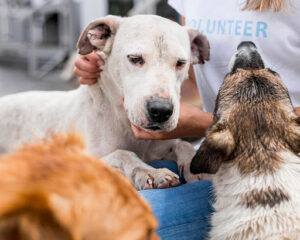 Image Source: Freepik
Image Source: Freepik
During disasters, pets can face a host of perilous situations. The following are a few examples:
Separation Anxiety: Pets may become anxious or agitated when separated from their owners during evacuations or while sheltering. This can lead to stress-related health issues.
Exposure to the Elements: Extreme weather conditions, such as extreme heat or cold, can be life-threatening to pets left outdoors or without shelter during a disaster.
Lack of Access to Food and Water: Disasters can disrupt the supply of pet food and clean water, making it essential to include provisions in your emergency kit.
Injury or Illness: Debris, sharp objects, or contaminated water can lead to injuries or illnesses for pets during a disaster. Having a first-aid kit and necessary medications on hand is crucial.
Getting Lost: The chaos of a disaster can cause pets to escape or become disoriented, increasing the risk of them getting lost. Proper identification and microchipping are important for reuniting with your pet if they go missing.
Disaster Preparedness for Pets
 Image Source: wirestock on Freepik
Image Source: wirestock on Freepik
In the face of unexpected disasters, it’s essential to have a plan to protect your pets. The following will ensure your furry companions remain safe and secure during challenging times.
Creating a Pet Emergency Kit
Prepare a pet emergency kit with the essentials: food and water supplies to last several days, medications and medical supplies, crucial identification and documentation like vaccination records and a recent photo, and comforting items such as blankets and toys to reduce stress during emergencies.
Designing a Pet-Friendly Disaster Plan
Creating a disaster plan that considers your pets is crucial. Identify safe evacuation routes, research pet-friendly shelters, and ensure you have the necessary transportation and carriers for your pets. This preparation and equipment can significantly enhance your pets’ safety during emergencies.
Assembling a First-Aid Kit for Pets
Putting together a first-aid kit for your pets is fundamental to disaster preparedness. Include items like bandages, antiseptic wipes, tweezers for splinter or tick removal, and any specific medications or ointments your pets may need. Being prepared to provide basic medical care can make a significant difference in your pets’ well-being during emergencies.
Microchipping and Tagging for Identification
Proper identification is essential in reuniting with your pets if they become lost during a disaster. Microchipping offers permanent and reliable identification. Ensure your pet’s microchip information is up-to-date with your current contact details. Additionally, use collars with ID tags, including your phone number. These measures can expedite the reunion process and provide peace of mind in a crisis.
Preparing an Emergency Contact List
Having an emergency contact list readily available is crucial for effective disaster preparedness. Include your veterinarian’s information, local animal control or shelter contacts, and trusted friends or family members who can assist with pet care during emergencies. These contacts will form a vital support network to ensure your pets’ safety and well-being during challenging times.
The Evacuation Process
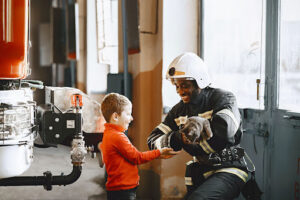 Image Source: Gustavo Fring on Pexels
Image Source: Gustavo Fring on Pexels
When it comes to evacuating your pets during a disaster, a well-structured plan is essential to ensure their safety and minimize stress.
Alert and Notification Systems: Stay informed by monitoring alert and notification systems. Many communities have emergency alerts through text messages, phone calls, or apps that can provide early warning about impending disasters. Sign up for these systems and ensure they include notifications for pet owners.
Evacuation Timeline and Readiness: Be proactive and aware of the evacuation timeline. If you receive a warning, don’t wait until the last minute to act. Have your emergency kit, including supplies for your pets, readily accessible. Keep your pets’ carriers and leashes in a convenient location to streamline the evacuation process.
Safely Evacuating with Your Pet: Always have a sturdy leash and harness on hand for dogs. Cats and other small pets should be in carriers or crates. These items are essential for controlling your pets during the evacuation process.
Ensure you have suitable carriers or crates for your pets. These should be well-ventilated, secure, and appropriately sized for your pets. Practice getting your pets comfortable with them in advance to minimize stress during evacuation.
Different pets have varying needs during evacuations. Dogs may require extra food, water, and exercise breaks. Cats and smaller pets may need a quiet, secure space in their carriers. Birds and reptiles may need specific temperature-controlled environments. Tailor your evacuation plan to accommodate these unique needs.
Keeping Pets Calm During Evacuation: Disasters can be frightening for pets, leading to anxiety and restlessness. Comfort your pets with soothing words and familiar items from their emergency kit. If space permits, bring along their favorite toys or blankets. Additionally, consider using pheromone diffusers or calming products designed for pets to help reduce stress during the evacuation.
Addressing these aspects of the evacuation process can ensure a smoother transition for both you and your pets during a challenging time. Proper preparation and a well-executed plan will go a long way in keeping your pets safe and calm during evacuation.
Sheltering in Place
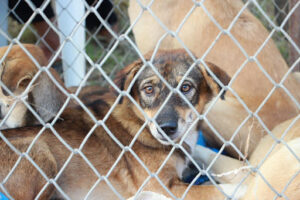 Image Source: Pranidchakan Boonrom on Pexels
Image Source: Pranidchakan Boonrom on Pexels
In certain situations, evacuating may not be an option, making it crucial to be prepared for sheltering in place during a disaster.
When Evacuation is Not an Option: There may be circumstances when leaving your home is not feasible, such as during a lockdown or if it’s safer to stay put. In such cases, being prepared to shelter in place is essential.
Preparing Your Home for Disaster: Securing Your Home: Prioritize securing your home against potential hazards. This may include reinforcing windows, doors, and roofs to withstand the impact of storms or protecting your home against wildfire threats. Ensure your pet is safely confined indoors or in a secure outdoor area.
Creating a Safe Space for Pets: Designate a safe area within your home where your pets can stay during the disaster. Ensure this space is free from hazards and stocked with essentials, including food, water, bedding, and toys.
Managing Food and Water Supplies: Be prepared with adequate pet food and clean water to sustain your pets for an extended period. Rotate these supplies periodically to keep them fresh. Additionally, have a plan for waste disposal, which may include lining a designated area with plastic and disposing of waste carefully.
Monitoring Your Pet’s Health: Keep a close eye on your pet’s health and well-being during the disaster. Be alert for signs of stress or illness and have a basic first-aid kit on hand to address minor injuries. If your pet requires medication, ensure you have a sufficient supply.
Sheltering in place requires thorough planning and preparation to ensure your safety and that of your pets. By securing your home, creating a safe space for your pets, managing essential supplies, and monitoring their health, you can better navigate the challenges of sheltering in place during a disaster.
Recovering After the Disaster
 Image Source: Freepik
Image Source: Freepik
After a disaster, returning home and rebuilding your life and your pet’s is a crucial phase in the recovery process.
Returning Home Safely: Upon returning home after a disaster, assess damage and hazards to ensure your and your pet’s safety, checking for structural issues, debris, and potentially toxic substances. Pay special attention to your pet’s safety by promptly addressing injuries or distress while providing access to clean water and a secure space within your home.
Reuniting with Lost Pets: If your pet was lost during the disaster, contact local animal shelters and rescue organizations, and use social media and lost pet websites to spread the word about your missing pet. Reuniting with lost pets may take time, but persistence and networking can increase the chances of a happy reunion.
Dealing with Trauma and Anxiety: Both you and your pet may experience trauma and anxiety after a disaster. Be patient and provide comfort to your pet during this difficult time. Consult a veterinarian or animal behaviorist if your pet’s anxiety persists or worsens. Seek support for yourself if needed, as your emotional well-being also plays a crucial role in helping your pet recover.
Rebuilding Your Pet’s Routine: Rebuilding a sense of routine and normalcy is essential for your pet’s well-being. Stick to regular feeding times and exercise routines, and provide familiar items and toys to help your pet adjust. Reassure your pet with affection and positive reinforcement as you both work towards recovery.
Recovering after a disaster can be challenging, but by carefully assessing your home’s safety, reuniting with lost pets, addressing trauma and anxiety, and rebuilding your pet’s routine, you can help ensure a smoother transition back to normalcy for you and your furry companion.
Community Resources and Support
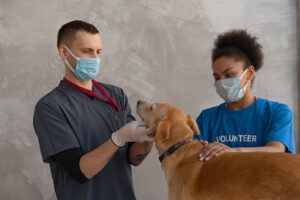 Image Source: Mikhail Nilov on Pexels
Image Source: Mikhail Nilov on Pexels
Communities rally together to provide crucial resources and support in the wake of disasters:
Local and National Organizations for Pet Disaster Relief: Specialized organizations offer assistance with pet evacuation, sheltering, and reuniting lost pets with owners during disasters, collaborating closely with emergency services.
Financial Assistance and Grants: Financial aid programs and grants help pet owners cover expenses like emergency veterinary care and temporary pet housing, ensuring pets receive necessary care.
Volunteer Opportunities: Volunteering with pet rescue and care organizations lets individuals actively participate in disaster relief efforts, aiding with pet evacuation, shelter, and reunification.
Community Disaster Preparedness Programs: Some communities provide disaster preparedness programs, including pet-specific preparations, offering resources, training, and guidance to ensure pets and their owners are well-prepared for emergencies.
Wrapping Up
In the face of disasters, our pets’ safety is paramount. This guide has covered vital aspects of pet disaster preparedness, from kits to community resources. By staying informed and proactive, pet owners can protect their furry companions. Preparedness not only ensures pet safety but also bolsters community resilience. With the knowledge and tools provided, you can be a steadfast guardian of your pets, ensuring their well-being during challenging times.


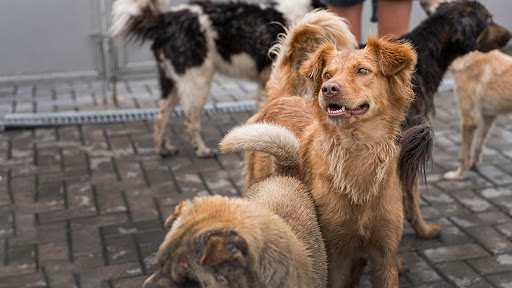
Leave a Reply